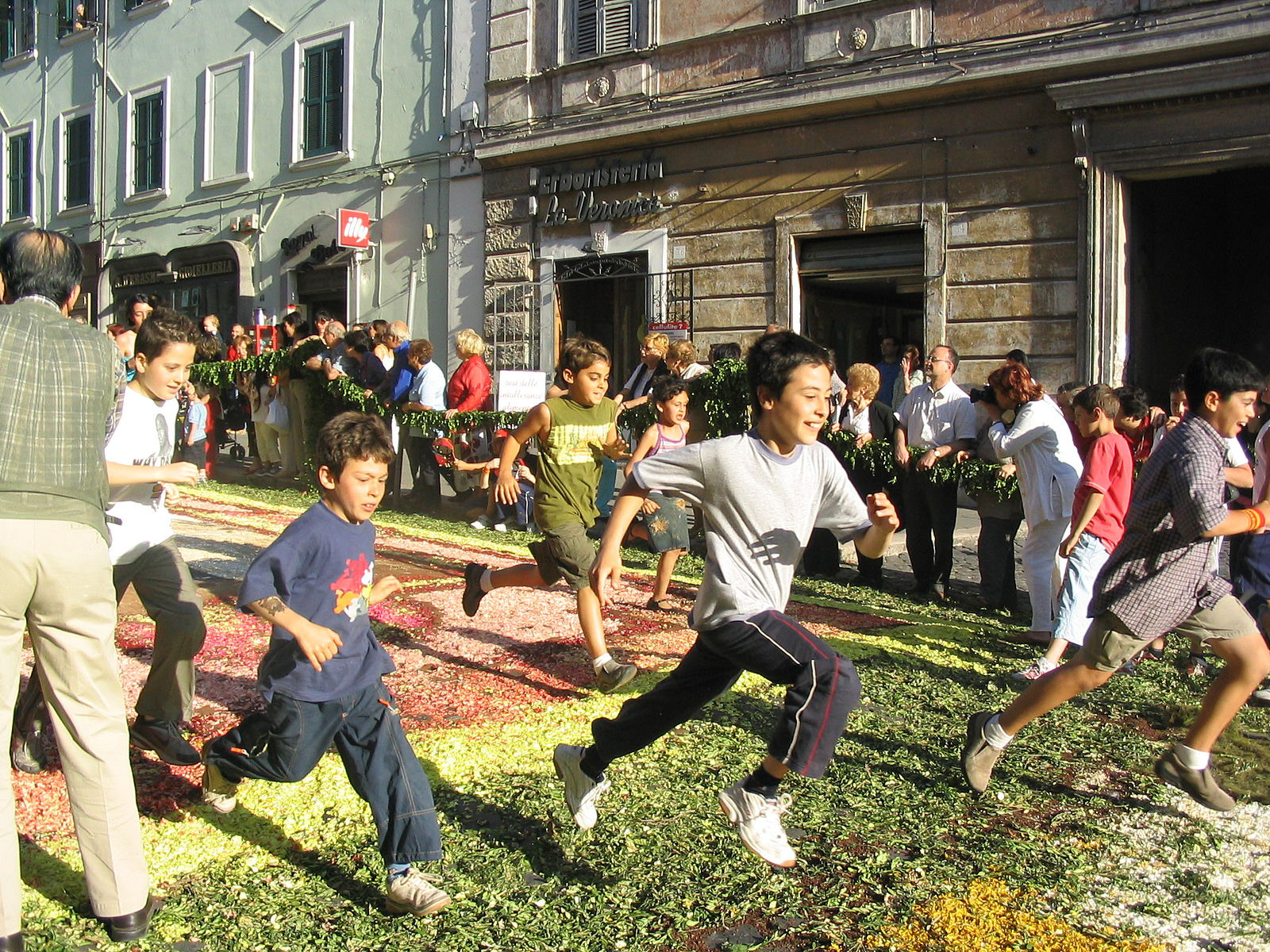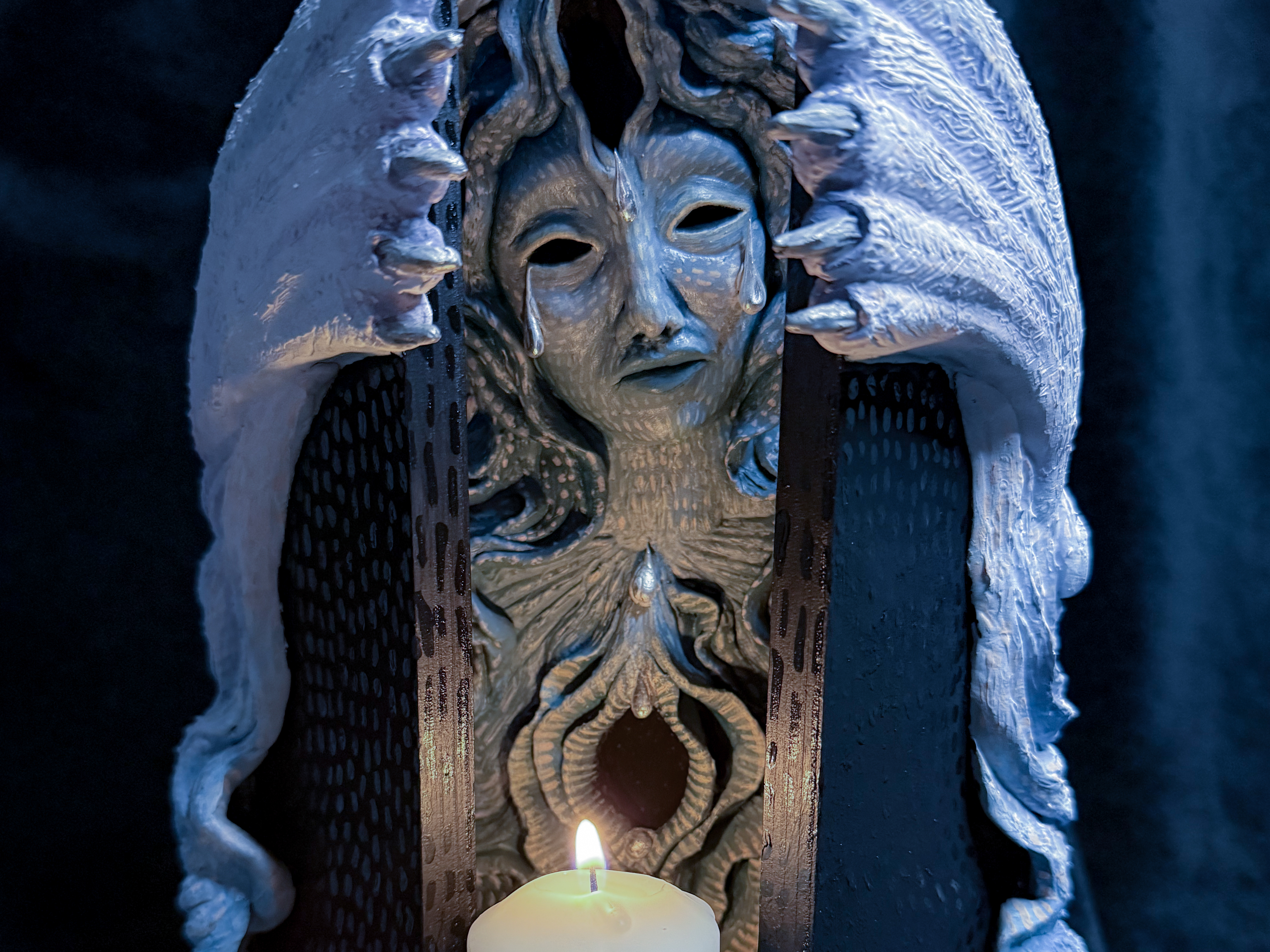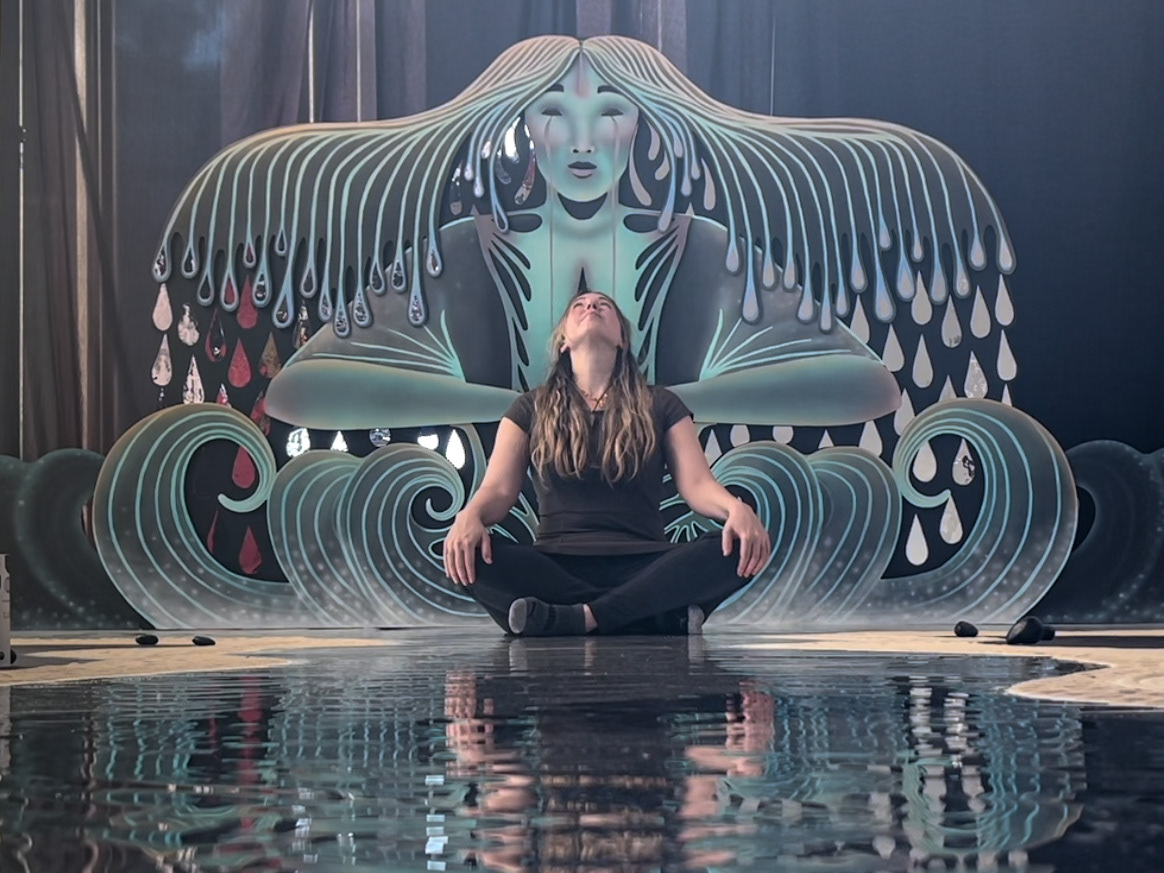Drawing with sand is an intricate process that requires a lot of attention and presence. This attention and presence is what makes sand painting a meditative practice, and has the potential to truly bless a space with continued intention and spirit. Sand painting adorns every square inch of a space with a living prayer. This is made even more impactful by the fact that sand is a fragile and temporary medium. One wrong step or gust of wind can undo hours of work. And yet, what is drawn cannot stay. Sweeping it away is a beautiful part of the process, where the temporary nature of life is acknowledged. It is also a way to temporarily elevate spaces - to declare them (and ourselves) sacred and even holy; only to dismantle that holiness and bring the space (and ourselves) back into the day-to-day. And yet, it feels like a homecoming, returning to the comfort of the lived-in and the well-worn.
The traditional Corpus Christi Festival in Italy called "Infiorata" does just this: turns entire streets and roads into drawings made with sand, flower petals, and other materials, transforming the every-day into holy spaces behind stantions. People walking by with their breath held in reverence who would dare not touch them. And yet, the flowers start to wilt, the wind starts to blow, and the festival season comes to an end. The most beautiful part of this festival, in my opinion, is the part at the end called the "spallamento," where the neighborhood children are finally allowed to run through all the drawings to gleefully mess them up. As beautiful as the transformation is from every-day to holy, so is the transformation from holy back to the every-day. This is the line I hope to walk in my sand installations. Similar Corpus Christi Festivals can be found in Guatemala, Mexico, Poland, and Spain.
I am also deeply inspired by the Slavic practice of "sypanie piaskiem," stemming from regions in rural Poland. Like daily protective sand drawing practices in India called "Rangoli," practitioners of sypanie piaskiem would make drawings out of sand in houses on earthen floors or on thresholds as a way to bless the space. It could be a daily practice, but as it's time-consuming it also is done to mark special occasions and holidays. The transformational power of the act to elevate a space, a family altar, a home, a plaza, or a walkway emanates through the designs.
Examples of Past Designs

Weeping willow on the riverbank

Sacred fish and tears forming a river from the Sea Goddess out to the Sea

Sand drawings lining the river of the Mother of Waters installation. Pictured are drawings of kolo (sacred community), salmonberries, underground sentience, rain, and tears.

The Tree of Life, a common symbol for Slavic and Baltic designs. The roots signify the underworld, the trunk and branches are mortal family, and the birds are witnesses to human life (and manifestations of the Sun Goddess Saule, or water spirits in other mythologies).

An eye mandala; eyes, tears, and sea foam.

Hands and incense for a spirit altar.

Closeup on fish and Sea Goddess tears

An eye mandala: eyes, tears, and sea foam.

Parting of the seas.
The Making of the Pouring Sand, Pouring Water, Pouring Light Installation
The making of the "Ojo" Sand Table Installation at Lakewood City Hall
The making of "Ojo," a sand art installation at Lakewood City Hall.
The final mini-installation, "Ojo," at Lakewood City Hall.
Community Sand Workshops
As important as the creation of these temporary installations is their destruction.
After the installation has been up for a set amount of time, we take down the barricades and invite the public in to experience the art in a new way. It's important for viewers to be able to touch and feel the sand art; to try out sand techniques for themselves, and in the process add something of themselves to the piece. It becomes a community art piece in this way.
Then, I invite participants to sweep up a small piece of the installation that means most to them. For some, it's the part they contributed. For others, it might be a certain part drawn by me from before the workshop. Then, we take our small jars of sand containing pieces of the installation to the nearest body of water.
In the case of the Mother of Waters installation (pictured below), we took our sand to the Foss Waterway where we could see Mount Tahoma (the mountain that inspired the Mother of Waters figure) in the distance. I had people reflect on all the forms the sand had taken before it became our drawing together, as well as all the forms it has yet to take once we return it back to the water. We then took a pinch of the sand and held it to our foreheads (the mountain), to our hearts (the river), to the place on our stomachs where we feel belly laughs and joy (the sound), and finally down to the water below (the ocean!). We reflected our the waters that connect us all, and how all of these pieces are connected. One of the attendees was climbing Mount Tahoma in the following week, and he took some of the sand from the exhibit with him to the summit of the mountain. So we connected with our watershed artistically, spiritually, and literally -- together!






Inspiration
Drawing with sand is a practice many cultures have in common all around the world. I draw the most inspiration from Slavic, Italian, and Mexican practices that either reflect my heritage or that of my family. I am also inspired by Buddhist styles, especially after having been a practicing Buddhist for most of my adult life. I am respectfully trying to understand more about these practices and to come to know them deeply, while also giving myself room to create something new that is reflective of my own current experience as a present-day ancestor for future relatives. Below are but a few examples of people who draw with sand around the world.

Destruction of Tibetan Buddhist sand mandala; monks spend days making an intricate mandala with different colored sand, then destroy it and bring it to the nearest body of water. The process symbolizes and enacts impermanence and non-attachment, and brings merit to all who witness or participate.

"Sypanie piaskiem," or the pouring of sand, is a part of the intangible cultural heritage of rural Central Poland. Patterns drawn on the ground in houses, thresholds, pathways, and courtyards brought protection and luck to families and community. The practice almost became extinct during the past 100 years, but is experiencing a recent resurgence as people seek to revive this cultural practice.

"Sypanie piaskiem," or the pouring of sand, is a part of the intangible cultural heritage of rural Central Poland. Patterns drawn on the ground in houses, thresholds, pathways, and courtyards brought protection and luck to families and community. The practice almost became extinct during the past 100 years, but is experiencing a recent resurgence as people seek to revive this cultural practice.
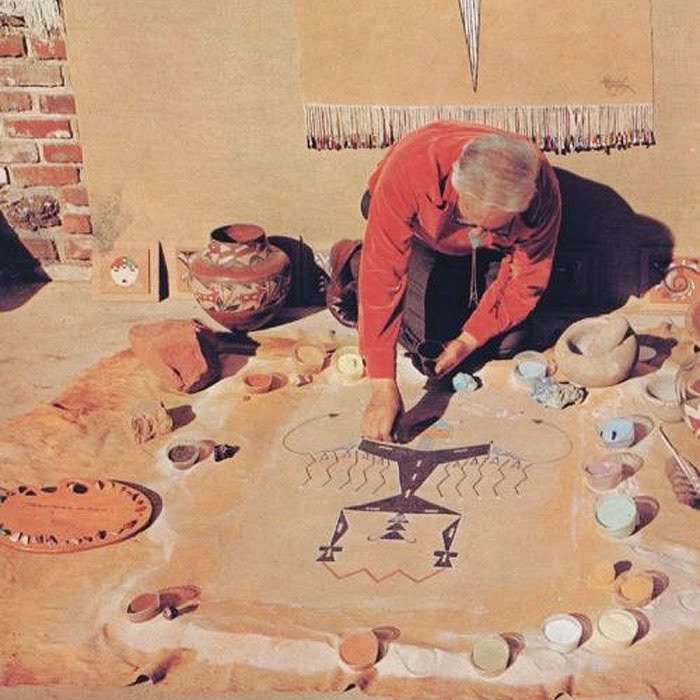
Navajo sand drawing tradition

"Sypanie piaskiem," or the pouring of sand, is a part of the intangible cultural heritage of rural Central Poland. Patterns drawn on the ground in houses, thresholds, pathways, and courtyards brought protection and luck to families and community. The practice almost became extinct during the past 100 years, but is experiencing a recent resurgence as people seek to revive this cultural practice

Making sand tapetes in Guatemala for the festival of Corpus Christi

"Sypanie piaskiem," or the pouring of sand, is a part of the intangible cultural heritage of rural Central Poland. Patterns drawn on the ground in houses, thresholds, pathways, and courtyards brought protection and luck to families and community. The practice almost became extinct during the past 100 years, but is experiencing a recent resurgence as people seek to revive this cultural practice

The Infiorata Festival in Italy sees entire roads and paths filled with designs made from sand, coffee grounds, limestone, flowers, pebbles, and other materials. Also a celebration of impermenance, the neighborhood kids are allowed to gleefully mess up all the drawings once the festival is over, in a tradition called "Il spallamento"

Polish Central rural sand and flower carpet making for Corpus Christi Festival

Navajo sand drawing tradition

An example of Rangoli, an Indian Hindu practice done in homes and thresholds. It can be a daily practice, but as it is time-consuming, it is more often done to mark holidays or special occasions.
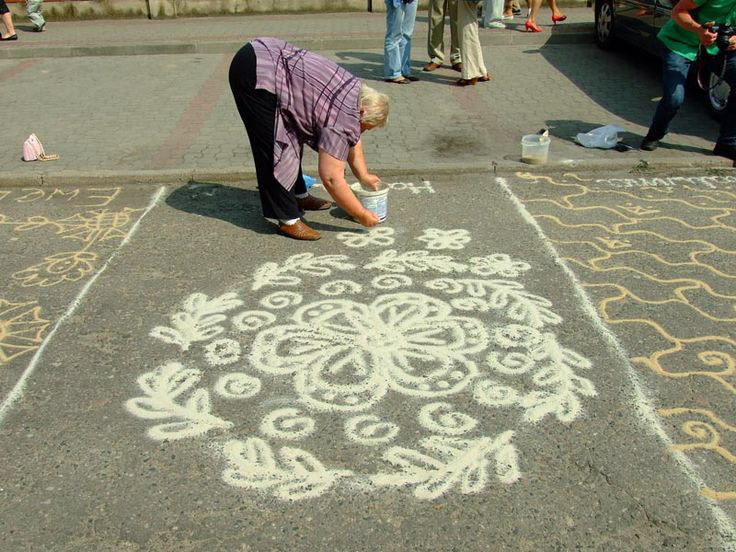
"Sypanie piaskiem," or the pouring of sand, is a part of the intangible cultural heritage of rural Central Poland. Patterns drawn on the ground in houses, thresholds, pathways, and courtyards brought protection and luck to families and community. The practice almost became extinct during the past 100 years, but is experiencing a recent resurgence as people seek to revive this cultural practice.
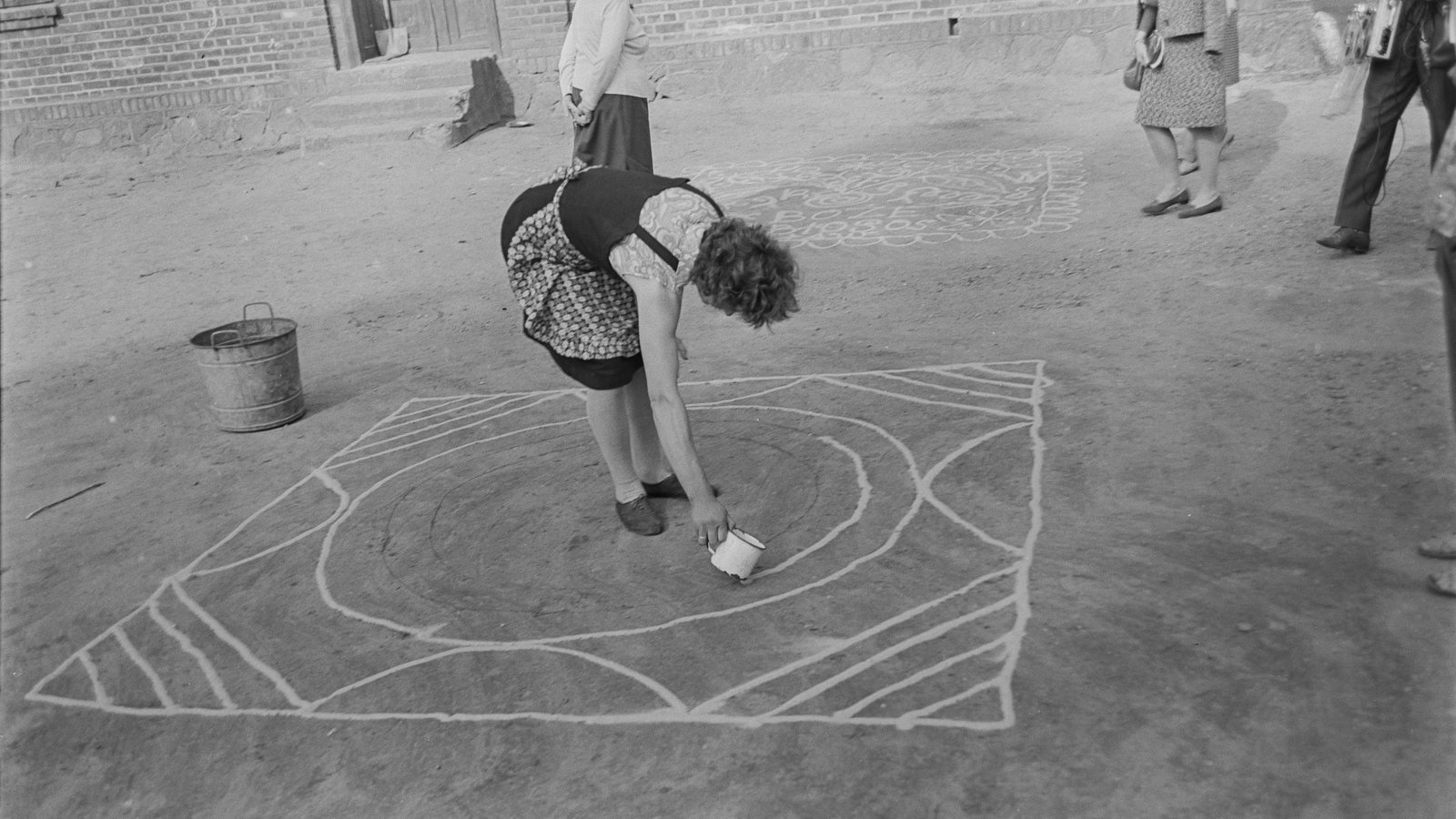
"Sypanie piaskiem," or the pouring of sand, is a part of the intangible cultural heritage of rural Central Poland. Patterns drawn on the ground in houses, thresholds, pathways, and courtyards brought protection and luck to families and community. The practice almost became extinct during the past 100 years, but is experiencing a recent resurgence as people seek to revive this cultural practice

"Sypanie piaskiem," or the pouring of sand, is a part of the intangible cultural heritage of rural Central Poland. Patterns drawn on the ground in houses, thresholds, pathways, and courtyards brought protection and luck to families and community.

A photo of how Polish sand drawing (sypanie piaskiem) was traditionally used to decorate earthen floors; photo from the Ethnography Museum of Mazovian Countryside in Sierpc.
